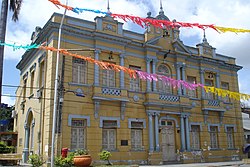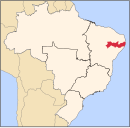Goiana
Goiana | |
|---|---|
Municipality | |
| The Municipality of Goiana | |
 Goiana town hall | |
| Nickname(s): One Museum Open at the Earth (Um museu aberto ao mundo),
A Cidade do Futuro (City of Future) | |
| Coordinates:07°33′39″S35°00′10″W/ 7.56083°S 35.00278°W | |
| Country | |
| Region | Northeast |
| State | |
| Municipal seat | August 3, 1892 |
| Government | |
| •Mayor | Eduardo Honório (PSL, 2021 – 2024)(current) |
| Area | |
| • Total | 501.17 km2(193.50 sq mi) |
| Elevation | 13 m (43 ft) |
| Population (2020) | |
| • Total | 80,055 |
| • Density | 150.72/km2(390.4/sq mi) |
| [1][2] | |
| Time zone | UTC−3(BRT) |
| Postal Code | 55900-000 |
| HDI(2010) | 0.651 –medium[3] |
Goiana(pronouncedIPA:[gojˈɐ̃nɐ]) is a city inBrazilin the northeast of the state ofPernambuco,[4]roughly 65 km north of the city ofRecife,51 km from the capital ofParaíbaand 2,187 km fromBrasília.
Its historic center was declared aNational Historic Landmarkin 1938.[5]It also has the easternmost continental point in its state, at Ponta do Funil in the coastal district ofPonta de Pedras.
Geography
[edit]Goiana is built on a fertile plain between theTracunhaém RiverandCapibaribe Rivernear their confluence, where they merge to form theGoiana River.The town is around is 25 km from the coast.[4]It is also the easternmost city in Pernambuco. The town is the commercial centre for one of the richest agricultural districts of the state, which produces sugar, rum, coffee, tobacco, cotton, cattle, hides andcastor oil.[4]Goiana is one of the oldest towns in the state, and was occupied by the Dutch from 1636 to 1654.[4]
The municipality contains most of the 6,677 hectares (16,500 acres)Acaú-Goiana Extractive Reserve,a sustainable use conservation unit created in 2007.[6]
History
[edit]This sectionneeds additional citations forverification.(May 2023) |
Originally occupied byBrazilian Indians,CaetésandPotiguaras,[7]the village became a parish in 1568 whenPortuguese explorerDiogo Diasbought ten thousand fathoms of land near the present city, then theCaptaincy of Itamaracá,establishing a fortified ingenuity in the valley of the Tracunhaém River. In 1574, the Potiguara population attacked the Tracunhaém sugar plantation, exterminating its entire population. This incident caused the end of the captaincy of Itamaracá and the creation ofcaptaincy of Nova Paraíba.[8]
On April 24, 1646, fitted with sticks, stones, pots, pepper and boiling water, the women of Tejucupapo, a small district of the city, won against the Dutch, who had threatened their land and families.
Goiana became a town on January 15, 1685 and earned forums on May 5, 1840.[citation needed]
Beaches
[edit]This section has multiple issues.Please helpimprove itor discuss these issues on thetalk page.(Learn how and when to remove these template messages)
|
- Carne de Vaca
Carne de Vaca (English:beef meat) is the first beach off the north coast of Pernambuco. It has a narrow sand strip, small waves and banks of sand before the natural reefs during the lowtide.It is located in a small village with a few homes. To the north there is the mouth of theGoiana River,and to the south there is the small Doce River.
- Pontas de Pedras
The Pontas de Pedras Beach has weak waves, fine sand and a lot of algae. It is located at the core of the village, where several fishing boats are always anchored. Together with Carne de Vaca, this beach is one of the most popular beaches in Goiana.
- Barra de Catuama
This beach still retains some nativeAtlantic forestvegetation.
- Catuama Beach
The Catuama Beach has clear water, reefs and wet sand. At low tide, there are sand banks, stones andnatural pools.It is located close to the village center, where there is also a church.
- Atapuz Beach
The Atapuz Beach is close to the intersection between theItapessoca Riverand Santa Cruz channel. Nearby, there is a chapel dedicated toSaint Sebastian.
- Tabatinga Beach
The Tabatinga Beach has palm trees,mangroveand holiday summer houses. It is located on a private farm.
Economy
[edit]The main economic activities in Goiana are based around theautomotive,pharmaceuticalandglassindustries, with the city hosting three important plants in these segments. The city hosts the most modern assembly plant of theFiat Chrysler Automobiles(FCA Group), which is responsible for the production of theJeep RenegadeandFiat Toro.[9][10]Goiana is also the land ofVivix,one of the biggest float glass industries inBrazil[11]as well asHemobrás,which produces blood derivatives and coagulation factor products.[12]
Goiana has an importantagribusinesssector, especially related to the farming and trading ofgoats,cattle,pigs,poultry,and plantations ofsugarcaneandcoconuts.
The city is one of the biggest national producers of sugarcane, with an estimated production of over 1.1 million tons in 2007.[citation needed]
Economic Indicators
[edit]| Population | GDPx(1000 R$).[13] | GDP pc(R$) | PE |
|---|---|---|---|
| 74.424 | 457.986 | 6.379 | 0.78% |
Economy by Sector 2006
| Primary sector | Secondary sector | Service sector |
|---|---|---|
| 13.21% | 29.38% | 57.40% |
Health Indicators
[edit]| HDI(2000) | Hospitals (2007) | Hospitals beds (2007) | Children's Mortality every 1000 (2005) |
|---|---|---|---|
| 0.692 | 3 | 122 | 19.8 |
Historic structures
[edit]The historic center of Goiana received provisional status as a national monument by theNational Institute of Historic and Artistic Heritage(IPHAN) in 2001. Nine religious structures were designated as national monuments of Brazil in 1938:
- TheChurch and Convent of Our Lady of Solitude(Convento e Igreja de Nossa Senhora da Soledade)
- The Convento e Igreja de Santo Alberto de Sicília
- Church of the Third Order of Mount Carmel(Igreja da Ordem Terceira do Carmo)
- The Igreja de Nossa Senhora da Conceição
- The Igreja de Nossa Senhora da Misericórdia
- Church of Our Lady of Protection(Igreja de Nossa Senhora do Amparo)
- The Igreja de Nossa Senhora do Rosário dos Pretos
- The Igreja Matriz de Nossa Senhora do Rosário
- The Capela de Santo Antônio - Engenho Novo[15]
See also
[edit]References
[edit]- ^Instituto Brasileiro de Geografia e Estatística (IBGE)."Goiana".Retrieved2020-11-20.
- ^"Ranking IDHM Municípios 2010".Retrieved2016-04-17.
- ^"IBGE Statistics".Retrieved2016-04-17.
- ^abcdOne or more of the preceding sentences incorporates text from a publication now in thepublic domain:Chisholm, Hugh,ed. (1911). "Goyanna".Encyclopædia Britannica.Vol. 12 (11th ed.). Cambridge University Press. p. 303.
- ^Centre, UNESCO World Heritage."Historic Centre of the Town of Goiás".UNESCO World Heritage Centre.Retrieved2022-12-08.
- ^RESEX Acaú-Goiana(in Portuguese), ISA: Instituto Socioambiental,retrieved2016-06-06
- ^"Índios: O Brasil antes do descobrimento".educacao.uol.br(in Brazilian Portuguese).Retrieved2022-12-08.
- ^Sugar heritage and tourism in transition.Lee Jolliffe (1st ed.). Bristol: Channel View Publications. 2013.ISBN978-1-84541-387-3.OCLC810586174.
{{cite book}}:CS1 maint: others (link) - ^"FCA Group - The Plant".fcagroup.Retrieved2016-04-17.
- ^"New Fiat Toro Pickup Truck Launches In Brazil With Two Engines".Carscoops.Retrieved2016-04-17.
- ^casulloweb.br, Casullo Agência Digital -."Vivix Vidros Planos | The Company".vivix.br.Retrieved2016-04-17.
- ^"Ipfa.nl".ipfa.nl.Retrieved2016-04-17.
- ^Goiana 2007 GDP IBGE page 29ArchivedMarch 4, 2016, at theWayback Machine
- ^PE State site - City by city profile
- ^"BENS TOMBADOS E PROCESSOS DE TOMBAMENTO EM ANDAMENTO"(PDF).Brasília, Brazil: IPHAN. 2016. Archived fromthe original(PDF)on 2017-01-10.Retrieved2017-09-18.
- Video Goiana of the future[1]



